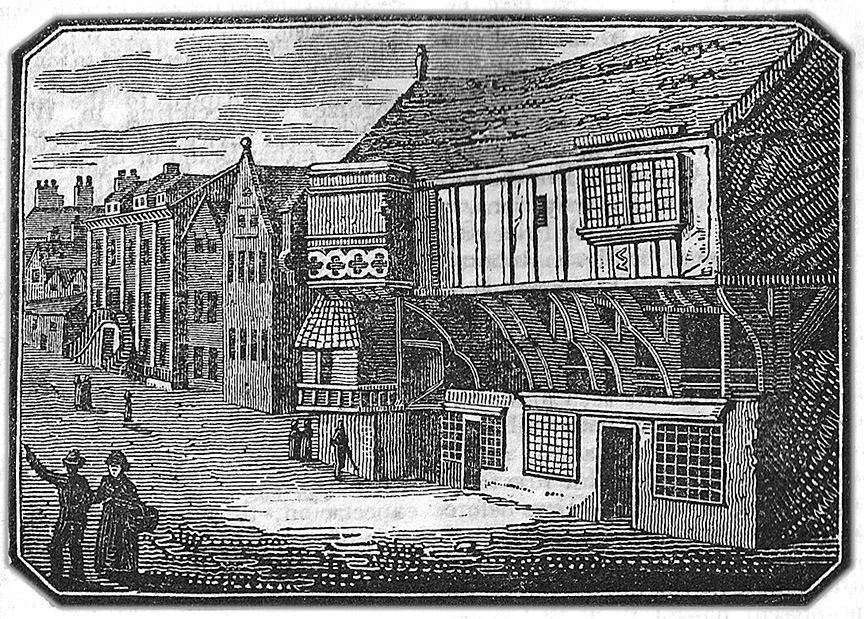
Old Photographs & Drawings of Chester
Old Lamb Row

Old Lamb Row was a timber building whose upper storey protruded so far over the street, and whose creaking beams sagged so fantastically, that it quickly achieved a reputation as being Chester's most picturesque building and was portrayed by many visiting artists, as we see here. Originally constructed as the home of historian and heraldic artist Randle Holme III in 1655, it was later converted into shops, a market and finally into an inn- The Lamb Inn, which gave its name to a long vanished Row, Lamb Row. So unfeasable was the structure, however, that the whole thing inevitably collapsed into the street in 1821. The Chester Chronicle reported at the time, "this ancient pile, like all the works of man, underwent a severe shock from the hands of time... the projecting portion of the south end suddenly gave way and tumbled into the street with a loud crash. An immense volume of dust rose from the ruins, and it was some time before bystanders could ascertain what damage was done and whether any injury had been sustained". |



The church visible behind the Lamb in several of these images was that dedicated to St. Bridget. It was founded as long ago as the year 797 by King Offa of Mercia on the site of the vanished Roman Southgate, or Porta Praetoria. It stood just across the road from St. Michael's Church which remains with us today, albeit deconsecrated and serving as the home of the excellent Chester History & Heritage, opened here in 1975 as Britain's first 'heritage centre'. Their proximity led to the area long being known as 'The Two Churches'. You can see them facing each other in the centre of this and its subsequent old maps of Chester.. In 1825, it was deemed necessary to demolish the millennia-old church when a new thoroughfare, Grosvenor Street, was cut diagonally through the ancient street plan to link the city with Thomas Harrison's new Grosvenor Bridge. The burials, both from beneath the church and from its long-vanished graveyard, were moved elsewhere- but not too thoroughly it seems, as, when gas works were being undertaken here a few years ago, the engineers came across large quantities of human remains lying not far beneath the modern roadway in a forgotten part of the old crypt. Harrison designed a new church to replace the lost one, bearing the same dedication, which was erected close to his recently-rebuilt Castle and opened in 1827. Harrison himself was laid to rest in its churchyard less than two years later, in March 1829. When this church was in turn demolished during the 1960s to make way for a traffic island on the Ring Road, his remains were transferred to Blacon Cemetery on the edge of the city. The exact location of Harrison's former vault is not certain but is thought to lie somewhere under the pavement in Grosvenor Street- and marked by a manhole cover- not much of a memorial to such a great man! Other gravestones do survive, however, and can still be seen today, both on a scruffy patch of land at the end of Grosvenor Street and on the traffic island itself! See some pictures of them here. |




Above: this view of the Falcon Inn shows an early representation of the later Lamb building to the right. Below: the building can be seen in this early photograph behind a banner proclaiming the "Falcon Cocoa House". Originally the brainchild of the Society of Friends- the Quakers- local cocoa houses came about due to pious concern that Chester's working folk were preferring to spend their time and money in warm and cosy pubs and 'gin palaces' rather than staying in with their families in their cold, damp homes- or even going to church. Interestingly, prominent among those reforming Quakers were the Cadbury and Fry families- chocolate manufacturers! Their concern, evidently, was as much about profits as moral improvement.. |

Old
Pics
of
Liverpool
&
Chester
|
Old
Maps
and
Aerial
Views
of
Chester
| Chester
Virtual
Stroll
| Site
Front
Door
Chester Gallery |
Site Index |
B&W
Picture
Place | Contact us | Lost Pubs of Chester Gallery | Next Page